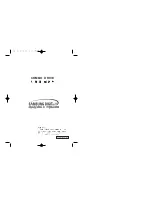
POSIDRIVE
®
FDS 4000
STÖBER
ANTRIEBSTECHNIK
10. Positioning Control
15
10.5.2
Continuous traversing range (rotary axis)
Unlimited position range (I00=1)
The most important feature of a continuous traversing area is
the cyclic repetition of certain positions for movement in one
direction (e.g., hand on a clock).
Rotary axis function:
Selecting
I00
=
1:unlimited
means that
the actual position is only counted up to
circular length
I01
(e.g., 360°). After reaching this value, you start over again with
zero. When both directions are permitted (
I04
=0 and
I03
=1),
the shortest path is taken for movement from point A to point
B (absolute target specification)
→
direction optimization
.
Gear ratio:
Parameters
I07
and
I08
can be used to specify the
exact gear ratio (using the tooth numbers). This prevents
drifting away with relative positioning. Cf. examples in
chap. 10.9.
Direction of rotation:
When both directions are permitted
(
I04
=0), the shortest path (
I03
=1,
direction optimization
active) is taken for movement from A to B with absolute target
specification. However, when the process block is changed on
the fly, the original direction of rotation is retained. Restriction
of the permissible direction of rotation (
I04)
affects all process
blocks and manual traversing. Another method is to deactivate
direction optimization with
I03
=0. To then be able to traverse
an absolute destination in the
negative
direction of rotation,
you must enter the destination with a
negative sign
while
taking the modulo calculation into consideration. Example:
After -270° is entered, the drive rotates
counterclockwise
to
position 90°.
10.6
Reference point traversing
When the position is measured with an
incremental encoder
,
the actual position is not known when the power is turned on
(power supply or external 24 V). A defined starting position is
achieved with reference point traversing. When an
absolute
value encoder
is used, only
one
drive referencing procedure is
required for commissioning and when an inverter is replaced.
Absolute movements can only
be performed in referenced
status. The referenced state is signaled with
I86
=1 and can be
output on the binary output.
Reference point traversing is parameterized with
I30
to
I38
.
The primary parameters are listed below.
•
I30:
Type of reference point traversing
•
I31:
Direction of reference point traversing
•
I32:
High-speed reference point traversing
•
I33:
Low-speed reference point traversing
•
I35:
Zero-pulse incremental encoder - evaluation
•
I37:
Automatic reference point traversing at power-on
There are three ways to start reference point traversing.
•
Automatically (
I37
=1 or 2)
•
Signal on binary input (
F31
...=24)
•
Inching with
J05
=1
Reference mode
I30
specifies the required initiators or the
functions for binary inputs.
I30
=
3:def.home
is frequently used
to set the machine zero point when
absolute value encoders
are used.
I31
is used to determine the (search) direction when
reference point traversing is started. If the reference switch (or
limit switch) is active, the direction is reversed. Cf. example 2
on the next page. The correct value for
I31
can be tested by
inching the axis (parameter
J03
), for example. The status of
the binary inputs can be scanned in
E12
,
E13
and
E19
.
When only one direction of rotation (
I04
) is permitted, the drive
traverses up to the
rising
edge of the reference switch in
direction
I04
at speed
I33
. Referencing direction
I31
is ignored
in this case.
The zero pulses of the incremental encoder are only evaluated
when
I35
=1. With inverters without option boards, the zero
track is connected to BE3.
Usually the zero track cannot be used with continuous axes
unless the mechanics have an even-number ratio.
Specification of two speeds (i.e.,
I32
and
I33
) is primarily an
advantage for long linear axes.
The
acceleration
during reference point traversing is ½ of the
maximum acceleration in
I11
. When the reference point is
detected, the actual position is set to
I34
(i.e., reference
position), and the drive brakes until it is at a standstill. The
distance required for reversal or braking is generally
1 v²
Distance = -------
2a
with V:
speed
a: Acceleration (
I11
/2 here).
After reference point traversing has been concluded, the drive
remains where it is after the required braking distance
(
I33
2
/
I11
) and does not return to the reference position. Cf.
above. The AE2 "override" function (
F20
=5) changes the
speed and also the braking distance.
















































